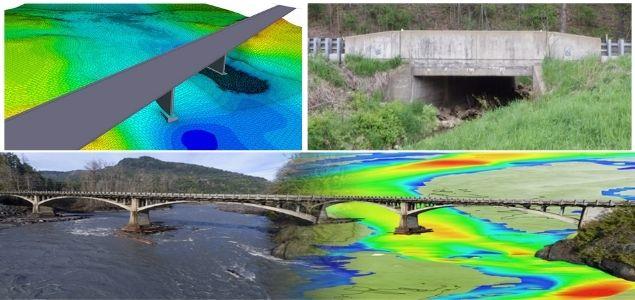
PennDOT continues to advance the Collaborative Hydraulics: Advancing to the Next Generation of Engineering (CHANGE) innovation.
The innovation involves shifting from one-dimensional (1D) to two-dimensional (2D) hydraulic modeling to provide improved understanding of the complex interactions between waterways and infrastructure. CHANGE is a Federal Highway Administration (FHWA) Every Day Counts Rounds 4 and 5 (EDC-4 and EDC-5) innovation that Pennsylvania championed.
Extreme weather events place added pressure on designers to incorporate better resiliency into infrastructure. 2D modeling is a critical tool to accomplish this objective. One dimensional modeling requires designers to make assumptions about stream flow characteristics to evaluate potential flooding impacts. Experience around the nation has shown this can lead to costly and destructive design errors.
Using 2D modeling, designers can produce varied and specific projected stream flows around bridge structures and evaluate the potential impacts on surrounding areas. Thousands of elements are shown representing floodplain geometry, and computations are performed at each element.
2D modeling enables more accurate designs of bridge openings, span arrangements, roadway profiles, scour countermeasures, and bank protection. It provides better tools for communicating interactions between waterways, the transportation network, and the environment; allows for a more streamlined project development approach; and improves the ability to design safer, more cost-effective, and resilient structures over waterways.
"The improved detail of 2D modeling helps designers evaluate risk, said Hydrology and Hydraulic Unit Manager in the Bureau of Project Delivery, Nicholas A. Vivian, P.E., who heads the innovation effort. "Most Department projects include private houses and property within the project limits, we need to ensure that the proposed improvements
will not increase flooding risk to these assets. These tools help us evaluate risk and mitigate the effects on property owners and their assets."
Four PennDOT engineering districts have selected bridges in which the new 2D hydraulic modeling tools are being used.
District 1 – The bridge carrying State Route 4007 over a tributary of Little Brokenstraw Creek in Bear Lake Borough, Warren County. The environmental permit has been approved. The district used 2D modeling to analyze and enhance the current hydraulic conditions of the proposed bridge.
District 2 – State Route 1011 over the Genesee River in Bingham Township, Potter County. The district held a kick-off meeting in March and has commenced design. The model will be submitted for review this summer.
District 3 – State Route 14 over Towanda, Tannery and Springbrook creeks in Canton, Bradford County. Due to its complexity, a consultant was hired, and a model submission is expected this fall.
District 11 – State Route 65 over Bennett Run in North Sewickley Township, Beaver County. The model is in review with plans to submit the permit to the Pennsylvania Department of Environmental Protection in the fall.
PennDOT had hoped that each of the 11 engineering districts would develop one bridge project during 2021 using the innovative design technique, said Vivian, P.E. However, a combination of the disruption caused by the COVID-19 pandemic and the installation of new CADD design software delayed the process.
"The pandemic, coupled with the CADD design software change, kept the Hydraulic Unit busy," Vivian said. "Our unit will work with the remaining Districts in the coming months to further advance the 2D modeling effort."
ABOUT THIS BLOG
Did you know PennDOT is directly responsible for nearly 40,000 miles of highway and roughly 25,000 bridges? We oversee programs and policies affecting highways, urban and rural public transportation, airports, railroads, ports and waterways, in addition to administering the state's more than 11 million vehicle registrations and 8.8 million driver's licenses.
So, how do we do what we do? And how can we help you travel in Pennsylvania — whether it be for business or leisure — in safe and enjoyable manner? Read PennDOT Way to learn more about the department, what we do, and how and why we do it.
TAGS
50-Year Anniversary, 511PA, Aggressive Driving, Airports, Autonomous Vehicles, Bicycles, Bridges, Child Safety, Community Relations, Construction, COVID-19, Distracted Driving, District 1, District 10, District 11, District 12, District 2, District 3, District 4, District 5, District 6, District 8, District 9, DOTcom, Driver and Vehicle Services, Emergency Responders, Employment, Equity, FAQ Friday, Human Trafficking, Impaired Driving, Innovations, Live Free Ride Alive, Maintenance Monday, Motorcycles, Older Drivers, PA Motorcycle Safety Program, Pedestrians, PennDOT Connects, Ports, Public Transit, Railroads, REAL ID, Road MaP, Roadside Beautification, Rural Roads, Safety, School Buses, Seat Belts, State Transportation Innovation Council (STIC), Sustainability, Teen Drivers, Throwback Thursday, Transportation Funding, Travel in PA, Welcome Centers, Winter, Work Smart, Work Zone, Yellow Dot
LATEST POSTS
PennDOT Continues Sharing, Updating Resources for Local Governments to Pursue Bipartisan Infrastructure Law Funding Opportunities
Norwin High School Wins 2024 ‘Innovations Challenge’
Demo Complete: I-95 CAP Project in Center City Philadelphia
PennDOT Archeologist Connects Past, Present, and Future
Lehigh Valley DUI, Highway Safety Task Force Hosts Law Enforcement Seminar
ARCHIVES
2024
2023
2022
2021
2020
2019
2018
2017

